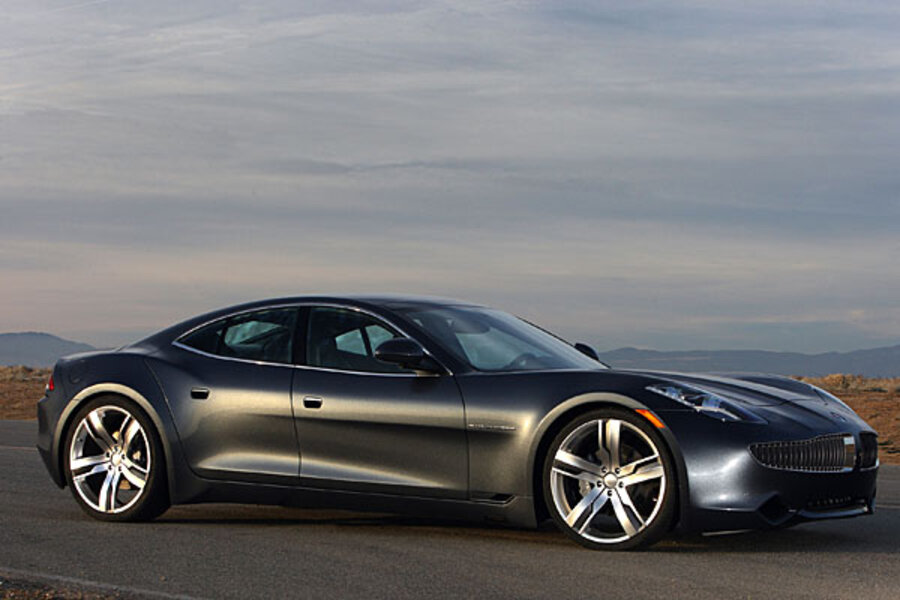Justin Bieber birthday: He got a Fisker Karma electric car. Should you?
A happy Justin Bieber birthday to all. And Justin, enjoy that new car that packs a zero-emission power train underneath its sleek, sports-car looks.
The pop star has turned 18.
During an appearance Thursday on "The Ellen DeGeneres Show," Mr. Bieber got a little surprise: a roughly $100,000 Fisker Karma, which bills itself as "the first true electric luxury vehicle with extended range and the freedom to plug in or fill up."
Bieber was, by all appearances, genuinely stunned by the gift, which came from his manager, Scooter Braun, and the singer Usher (a friend of Bieber).
"I always yell at you, don't get anything flashy, we're not about that. Be humble, be humble," said Mr. Braun. "I kind of broke my own rule."
"We wanted to make sure, since you love cars, that when you are on the road you are always looking environmentally friendly, and we decided to get you a car that would make you stand out a little bit," he added.
A little bit?
A little bit of understatement.
The Fisker Karma arrives in Bieber's hands fresh off of being named Automobile Magazine's Design of the Year. The premium luxury sedan, the editors said, “stands to become an icon, even without mention of its range-extended electric powertrain.”
The magazine's design editor, Robert Cumberford, called it "a beautiful and highly dramatic automobile, unlike anything else on the road today and yet very much like dozens of the most beloved sports cars of the past."
Do you want one, too? Should you get one?
That may depend a lot on whether that $100,000 price tag sounds within reach, and on whether you want to be a pioneering customer of a new company relying on relatively new electric battery technology.
Henrik Fisker, a designer with a background designing powerful cars at BMW and Aston Martin, founded Fisker Automotive in the US in 2007 to focus on premium plug-in hybrid cars.
The folks at Fisker have likened the profile of the Karma, their first model in production, to that of a running cheetah.
Here's reviewer Charlie White on the tech website Mashable.com, who sat in the car during the Consumer Electronics Show in Las Vegas in January:
"Once you sit down it feels like you’re wearing it rather than sitting in it. We liked its swank leather interior, made of 'low carbon' leather that was manufactured in the greenest possible way, in keeping with the overall theme of the vehicle," Mr. White writes.
"It’s had a bit of trouble with its batteries," he added. He referred to some cars recently being shipped with batteries that presented a potential fire hazard, an issue the company was working out.
Note that its 50-mile range, before shifting from electric to gas power, is lower than the 100-mile range of leading all-electric cars like the Nissan Leaf.
Another potential negative for drivers with a conservative or libertarian bent: Fisker (like electric rival Tesla Motors) has been a recipient of big federal loans as part of President Obama's green-energy strategy, which critics call a waste of taxpayer money.
One car-review website, the Car Connection, gives the Fisker Karma an overall rating of 7.6 on a scale of 10, a bit lower than other high-end cars like the Audi A6, BMW 5-Series, or Aston Martin Rapide.
Among electric vehicles, the Tesla Model S is another high-end offering that comes with a much lower price tag than Fisker, but also less of a wow factor in design.
The Car Connection gives the Karma high ratings on safety, features, fuel economy, and interior/exterior looks. But it lost ground for some quality glitches, having "remarkably little space inside for a vehicle that looks so imposingly large," and performance that "is not as tight or lithe through the curves as its German competitors of the same size."
But don't let any negatives, get to you, Justin.





